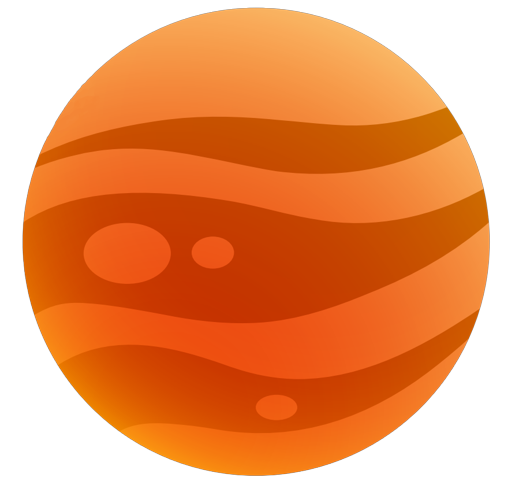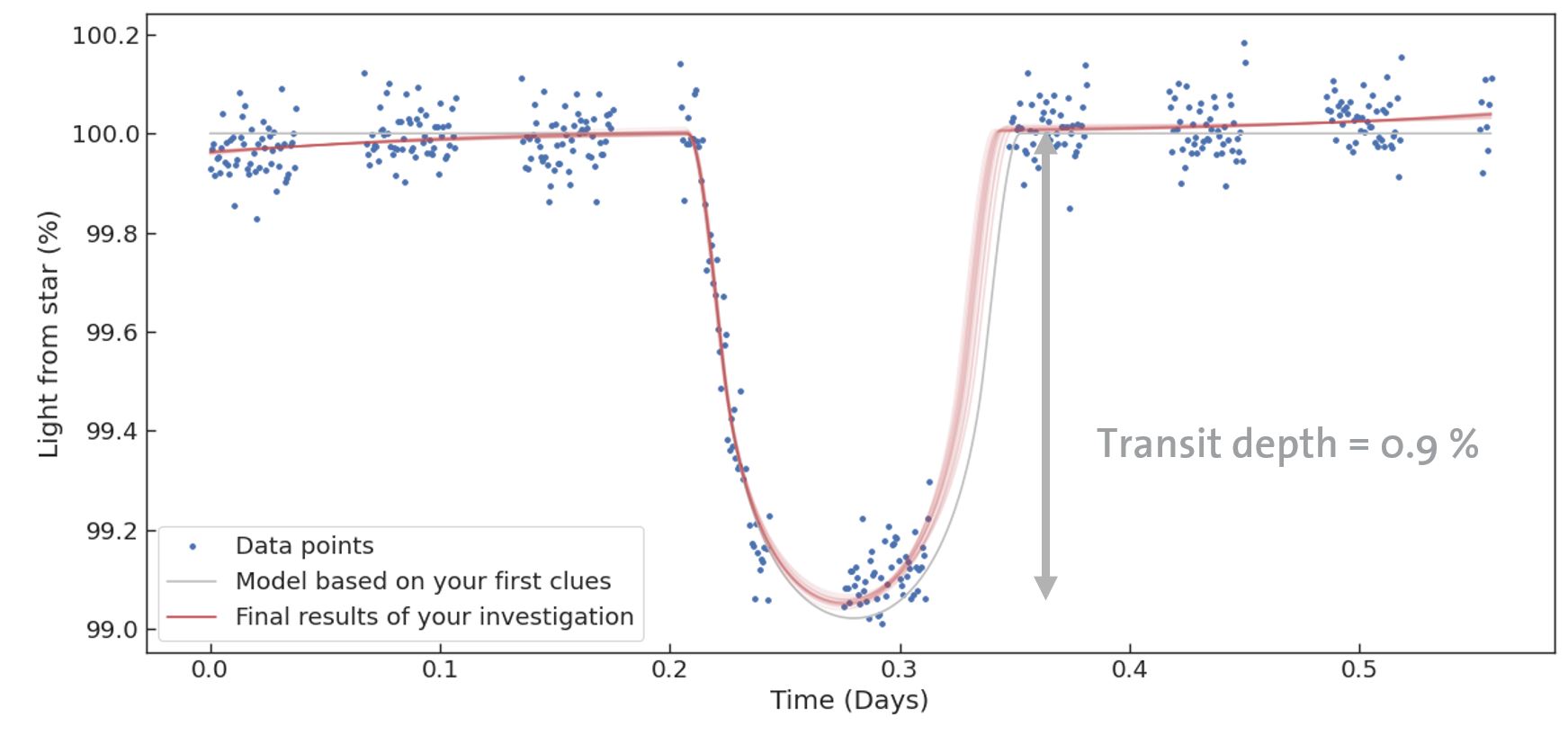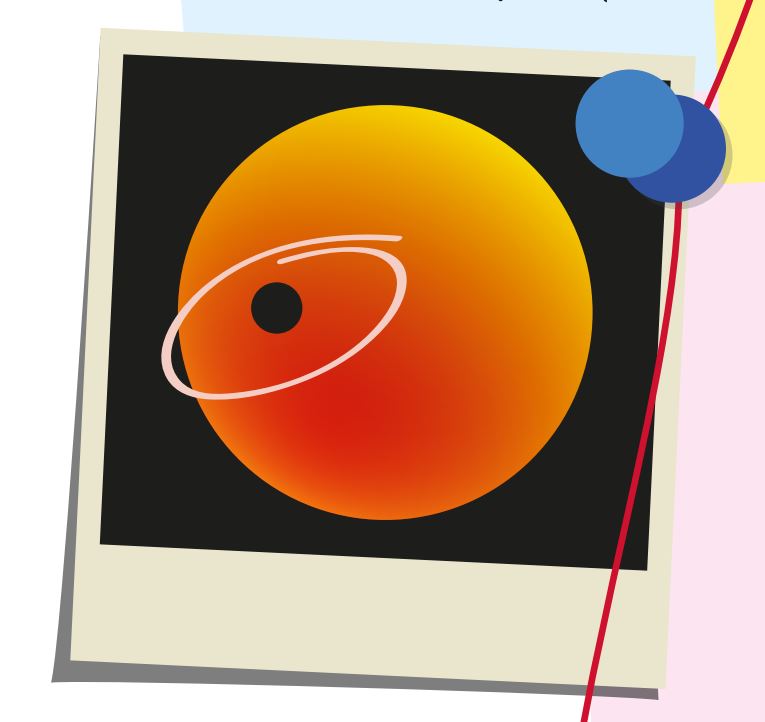
Mini-challenge
BEGINNERS LEVEL
12 to 18 years old
Complete this investigation
to discover how to analyse satellite data to uncover the size and orbital
period of exoplanets and become a real exoplanet detective.

Question 1
Exoplanets are planets orbiting stars other than our Sun. We have discovered over 5000 exoplanets, but they are difficult to detect, as the signal received from them is small in comparison to the much larger signal coming from their bigger, brighter host stars.
How are exoplanets detected?
Choose one or multiple options.

- By spotting the exoplanets directly
- By traveling to the exoplanets
- By measuring variations in the host star movement
- By measuring variations in the light that we receive from the star
- By spotting the exoplanets directly
- By measuring variations in the host star movement
- By measuring variations in the light that we receive from the star
Question 2
One of the methods to detect exoplanets is transit photometry. The exoplanet is detected by measuring a dimming in the light coming from the star when the exoplanet passes in between the star and the telescope. This is called an exoplanet transit.
A light curve is the measurement of the light of the host star over a period of time. The size of the dip in a light curve of a star during an exoplanet transit is called transit depth.
What is the transit depth in the light curve representation in Figure 1?

Choose one option.
- 10%
- 1%
- 8%
- 0.8%
Question 3
Let’s now analyse a real light curve from the KELT-3 star. The data were acquired by ESA’s Cheops satellite in January 2023.
Analyse the light curve. Measure the transit depth of the exoplanet KELT-3b and estimate its radius using the equation below.
\text{radius of the planet} \approx \sqrt{\text{radius of the star}^2 × \frac{\text{transit depth}}{100\%}}
The radius of the star KELT-3 is 1.7 times the radius of the Sun.
What is the radius of the exoplanet KELT-3b?

Choose one option.
- Approximately 0.16 times the radius of the Sun
- Approximately 1.6 times the radius of the Sun
- Approximately 0.43 times the radius of the Sun
- Approximately 0.04 times the radius of the Sun
The correct answer is 0.16 times de radius of the Sun.
Let’s go through the calculation in detail:
Figure 2a: KELT-3b data from Cheops with the transit light curve best fit model from allesfitter with transit depth estimation.
The radius of the star KELT-3 is known and provided:
\thickspace \thickspace \text{radius of the star} = 1.7 × \text{radius of the Sun}
By analysing the Cheops data we can measure the transit depth to be approximately 0.9\% (Figure 2a).
Using the equation:
\thickspace \thickspace \text{radius of the planet} \approx \sqrt{\text{radius of the star}^2 × \frac{\text{transit depth}}{100\%}}
\thickspace \thickspace \text{radius of the planet} \approx \sqrt{{(1.7 × \text{radius of the Sun} )}^2 × \frac{0.9\%}{100\%}}
\thickspace \thickspace \text{radius of the planet} \approx 0.16 × {\text{radius of the Sun}}
You can also compare this value with Earth by converting to Earth radii units.
\thickspace \thickspace \text{radius of the Sun} \approx 109 × \text{radius of the Earth}
\thickspace \thickspace \text{radius of the planet} \approx 0.16 × 109 \approx 17.44 × \text{radius of the Earth}
Question 4
What is the orbital period of this exoplanet?

Choose one option.
- 1 day
- 1.5 days
- 2 days
- 2.5 days
The correct option is 2 days.
Question 5
You are now ready to interpret the measured light curve of K2-141. The data were acquired by ESA’s Cheops satellite in September 2023.
Analyse the light curve in Figure 4. Describe what information you can retrieve from this data set.

Extra information: K2-141 star radius is 0.7 times the radius of the Sun.
Do you see anything unusual in the plot?
Explain your observations.
Question 6
Exoplanets are very diverse, they can have different sizes, masses, and temperatures. We can group them into different types by relating their properties to the planets in our Solar System.
Analyse the characteristics of all the planets and exoplanets below. Connect each exoplanet’s type with its name.
-
Hot Jupiter
-
Mini-Neptune
-
Super-Earth
-
K2-141b
-
KELT-3b
-
TOI-560c

Earth
\footnotesize \text{radius} = 1 × \text{radius of the Earth} \footnotesize \text{mass} = 1 × \text{mass of the Earth} \footnotesize \text{temperature} = 15 \degree C

Jupiter
\footnotesize \text{radius} = 11.21 × \text{radius of the Earth} \footnotesize \text{mass} = 317.8 × \text{mass of the Earth} \footnotesize \text{temperature} = -110\degree C

Neptune
\footnotesize \text{radius} = 3.88 × \text{radius of the Earth} \footnotesize \text{mass} = 17.1 × \text{mass of the Earth} \footnotesize \text{temperature} = -200\degree C

KELT-3b
\footnotesize \text{radius} = 17.5 × \text{radius of the Earth} \footnotesize \text{mass} = 617 × \text{mass of the Earth} \footnotesize \text{temperature} = 1543 \degree C

TOI-560c
\footnotesize \text{radius} = 2.4 × \text{radius of the Earth} \footnotesize \text{mass} = 10 × \text{mass of the Earth} \footnotesize \text{temperature} = 225 \degree C

K2-141b
\footnotesize \text{radius} = 1.5 × \text{radius of the Earth} \footnotesize \text{mass} = 5 × \text{mass of the Earth} \footnotesize \text{temperature} = 1830 \degree C
Temperature refers to average temperature on the surface of the planet.
Size of the planets and exoplanets not to scale.
The correct solution is:
- Hot Jupiter — KELT-3b
- Mini-Neptune — TOI-560c
- Super-Earth — K2-141b
Question 7
As of today, Earth is the only location in the Universe that we know of with life. The oldest dated fossils on planet Earth are 3.7 billion years old. When life first formed in our planet conditions were very different.
Do you think life could exist in any of the three exoplanets listed before?
Explain why.

Continue your investigation work by analysing in detail the Cheops data from KELT-3b, TOI-560c or K2-141 planetary system.







